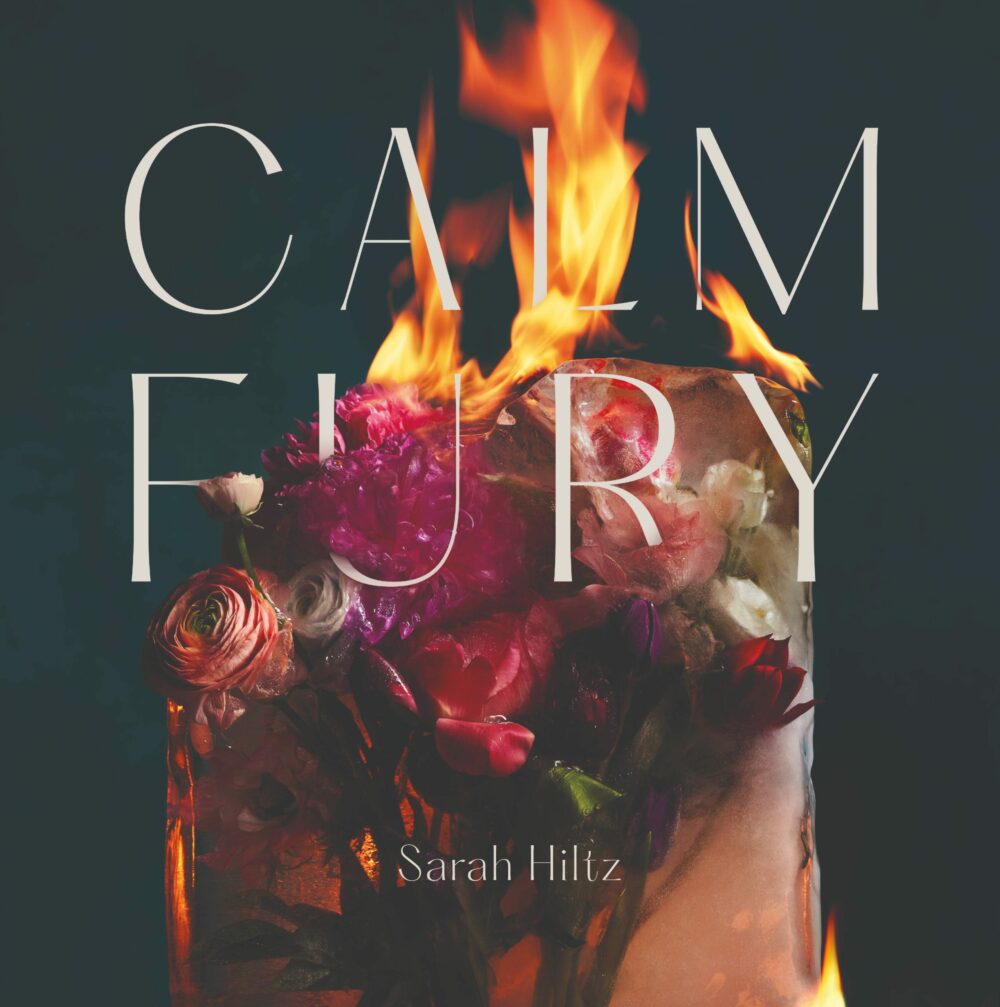Toronto-based contemporary folk artist Sarah Hiltz has released her latest album, Calm Fury, an eclectic collection of tracks exploring the complexities of anger as an emotion. Through rich storytelling and moments of sonic tension, reflection, and release, the album cycles through the energy, vulnerability, and eventual acceptance of anger.
We caught up with Sarah Hiltz to get to the root of anger as an emotion, why it makes us so uncomfortable, and what she learned along the way while writing Calm Fury.

Calm Fury was inspired by the research that you had done into the ways Canadians experience, express and repress anger. Why did you choose anger as an emotion to explore?
Because I discovered that I had a lot of anger, and that came as a surprise to me. I had just repressed it so much through my life. And then once I realized this is an emotion that I actually have a lot of, and started to try accepting that for myself, I realized I actually don’t know how to hold this emotion properly. It either lands me in repression and depression, because I’m not owning my own feelings. Or when I was trying to express it to people, it just turned out to be really destructive. And so that was why I thought, you know, I think I have to do some learning about this personally. And why not just make music about it at the same time? Because that’s what I do as a songwriter is write about what I’m going through.
I think most people probably don’t know how to express or deal with anger. I think it’s an emotion that is really hard to grapple with. When you were doing your research, was there anything you learned that seemed surprising or an anecdote that really stood out to you?
I spoke to a lot of different people and would ask them about their childhood experiences growing up with anger, and what I found really interesting is that people don’t all experience it the same way that I do. Some people are comfortable being angry, some people don’t feel loads of shame and guilt about it. So that, to me, was just really interesting because I felt so uncomfortable with it. When I would observe people in the world being outwardly angry, it would create fear in me. It’s something kind of unknown, but also, maybe, like a feeling of indignance. You know, I’d be like, “get yourself together. Can’t you control it?” I think I just, personally, tend to moralize everything. So if somebody is expressing anger, I think, “why don’t you just do the right thing and tone it down?”
So that was a really important piece of learning, for me, to realize that not everybody views it the same way as I do. And in fact, some of those people who are expressing themselves more outwardly are probably handling it in a more healthy manner than I was.
You also explore women’s anger specifically in the album. I think a lot of times, women are encouraged to hide their anger, “ladies should be subdued,” as you sing in Retching in the Wings. Women’s anger is not taken as seriously as men’s and I think that is something most women can really relate to. How did you go about exploring such a universal experience through music?
I think through a lot of conversations with different women, that sort of illuminated the universality of what we’re experiencing. As a songwriter, I always feel like the things that we experience as humans are often a lot more common with other people than we realize. Even though I’m writing about things that a lot of us go through, I always try to make it really specific for myself. I think in doing that, it means that I can write it, and I can perform it in a really authentic way, which is what connects with other people in their own experience because I’m being truthful and open about my own experience with that topic.
[youtube https://www.youtube.com/watch?v=2hvRKZs33w0]
Is there anything you would want listeners to take away from the tracks exploring that topic?
I hope that when male-identified people are hearing it that they consider the experience of a woman in a different way. It’s just like the line in Retching in the Wings, “that’s the cost of living when you are a woman who has something to say.” I feel like every woman who hears that song can understand. I don’t think a lot of men know the cost of what it takes for us to bring forth a difficult emotion or how much we’re policing ourselves in the way that we express what we’re going through. So I hope it will make some people take a moment of pause and feel less threatened by women’s anger.
You know, it is a difficult emotion. It makes me uncomfortable. It makes other people uncomfortable. And I am finding that I’m making a lot of people uncomfortable just by talking about my own anger. Even when I think I’m doing it calmly, I’m still finding that people are a little bit uncomfortable with it. I guess what I hope is that people can learn to be okay with being uncomfortable because I feel like we chase after comfort a lot. And in doing so, we miss out on so much because there’s so much to be learned and gained through withstanding discomfort in life.
[youtube https://www.youtube.com/watch?v=3tu4mf5R6dw]
There’s a story of when you were first writing the title track Calm Fury, you were sitting out on your balcony, and you had this interaction with a few men who seemed to be quite angry and aggressive themselves. And they asked you about what you were writing, so you quoted some lines to them from the song. Was there anything about their reaction that surprised you? What was that interaction like?
I’m sitting on the second-floor balcony, and they’re downstairs on the steps to my apartment. They don’t live in my building or anything. And I remember overhearing their conversation, they were just sort of rough around the edges and egging each other on. Then one man just called up, “Oh, you’re playing a song! What song are you playing?” I said, “Well, I’m actually writing a song.”
He asked how it was going and I remember thinking, “this man doesn’t want to hear this song that’s directly talking about men who can’t handle a woman expressing her anger.” And so I told him it’s about people who react strongly to women expressing anger, and he was like, “Oh, okay. All right. All right. Yeah.” Just sort of nodding his head and being pretty smiley about it.
I mentioned to him that the chorus says, “this is calm fury, this is controlled burning, don’t take everything so personally.” And so I explained to him that I was researching controlled burns, the way that they do that in forests to prevent wildfires, and that space is kind of where they can prevent the fire from continuing. So I just explained those lines, and he seemed to think it was alright. I thought, “Okay, this is exactly the person that I hope I can appeal to with a song like that.” Someone who, you know, seems to want to dominate the world with a strong emotion.

Sarah Hiltz Photo by Nick Wong
I think May I Rage, May I Love is one of the songs that really shows the kind of duality of anger and, like you said, sitting in discomfort and being okay with that. Do you think there’s any way that anger can lead to good or be channelled into a positive outcome?
I do think so. Absolutely. I think anger is the initial response that we have to a boundary being crossed or to the recognition that something is wrong. That initial response is important to alert ourselves, right? And I feel like the energy that comes with anger is something that allows me to summon the energy to address an issue or a problem.
I feel like throughout history – like all of the social causes and things that we see progressing – I don’t think that the people at the forefront of those movements are people who are not in touch with their anger. I think they are in touch with it and they have learned and, sometimes mastered, the art of transmuting that into a positive energy. That’s still something I’m working on for sure. I don’t always know how to move from that uncomfortable space of holding anger into positive energy.
[youtube https://www.youtube.com/watch?v=vbPYmitet0w]
In your research, you also looked at how anger affects the body and how the body holds anger in different ways. How did that research impact the musicality of the album and the musical choices you made?
The album has quite a few moments of odd time signatures, which is something I haven’t really done a lot of before. For example, Bad Cycle came from an improvised melody. I just heard a melody and sang it into my phone. Later, when I went back to try and work on it, I realized it was in 11/4 time. And I thought, “Okay, well, singing out a melody in 11/4 time is ridiculous, I’ll make it be in 12, at least, or something.” And I tried to play it in 12, and it just didn’t feel right. Like, it had to be in 11 and that song is all about repressing the anger and the way that it shows up in the body when you’re not allowing yourself to actually acknowledge it. So, it goes through tempo changes and time signature changes throughout that song.
I feel like it’s a quite unsettling song, and that’s maybe the appropriate way to feel when you’re angry about something, but you just don’t pay attention to it. And then, the antidote song to that is the one right after called Darling, I Suffer. I wanted it to feel really calm and releasing. So I always imagine, at the end of that cycle, everything is chaos, and I just want the song to be over. The song sort of floats like a feather down and lands with Darling, I Suffer, providing a sense of comfort and release.
Darling, I Suffer was specifically inspired by a book I read that says when you’re angry, you need to go to the person who’s made you angry and say, “darling, I’m suffering, you’ve made me angry and I need your help.” So, rather than it being this aggressive confrontation, it is an invitation to get through something together, which is so difficult to do when you’re angry with somebody. But that’s the contrast between a bad cycle where you’re just holding on and it eats away at you versus realizing we’re all human. And it’s not really anybody’s fault if I’m angry. It comes down to sort of acknowledging your own reactions.
There are a lot of moments like that in the album with those softer, more vulnerable songs. It’s not something you expect to hear when you think about an album that’s inspired by anger. Do you think there is a tie between anger and vulnerability?
I do think so. I think of anger as being that initial response to that boundary crossed or the recognition of something going wrong. I think that is probably a lot of times a reaction to feeling vulnerable. Like, something has made us feel vulnerable. And anger is the way we protect ourselves. So, they do feel very linked to me.
I think the challenge is, rather than hardening into our defence mechanisms, is to stay in a vulnerable space. To still try to extend love even when you feel vulnerable. Obviously, in some situations, if you’re not safe, that’s not the right thing to do. But in reciprocal relationships, where there’s care involved, or even if it’s like a stranger on the street who’s just done something that pisses you off. If you can respond with your own vulnerability, it can help you move through your own anger and potentially help that person to become more aware of the way that their actions affect other people.

